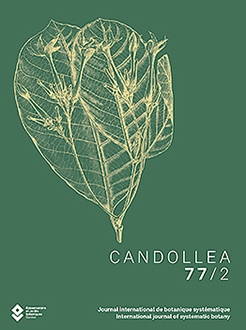Turner, I.M. (2022). An overlooked name provides the basionym for a new combination in Malagasy Tarenna (Rubiaceae). Candollea 77: 237–240. In English, English and French abstracts.
Pavetta madagascariensis Ten. (Rubiaceae) is an overlooked name described from material grown in the Naples Botanical Garden. The name is here transferred to Tarenna Gaertn. as T. madagascariensis (Ten.) I.M. Turner, and it becomes the correct name for the species currently referred to as T. grevei (Drake) Homolle. Neotypes are designated for Pavetta madagascariensis and P. gracilis A. Rich. ex DC. respectively and a lectotype for Ixora grevei Drake.
First published online on November 23, 2022.
Turner, I.M. (2022). Un nom oublié fournit le basionyme d'une nouvelle combinaison de Tarenna (Rubiaceae) à Madagascar. Candollea 77: 237–240. En anglais, résumés anglais et français.
Pavetta madagascariensis Ten. (Rubiaceae) est un nom oublié décrit à partir de matériel cultivé dans le jardin botanique de Naples. Le nom est ici transféré à Tarenna Gaertn. sous le nom de T. madagascariensis (Ten.) I.M. Turner, et il devient le nom correct pour l'espèce actuellement désignée sous le nom de T. grevei (Drake) Homolle. Des néotypes pour Pavetta madagascariensis et P. gracilis A. Rich. ex DC. sont désignés respectivement et un lectotype pour Ixora grevei Drake.
Introduction
Nomenclatural databases are rarely perfect. The vagaries of fate can result in omissions from the best-organised compilations. So it is with the Index Kewensis and its successor, the International Plant Names Index, and an example of such an omission is discussed in this note. It concerns the validly published name: Pavetta madagascariensis Ten. (Tenore, 1845). Despite Rippa (1935) drawing attention to the absence of this name from Index Kewensis, it is still missing. Rippa (1935) noted that the species was described by Michele Tenore (1780–1861) from plants growing in the Naples Botanical Garden. These were cultivated from material introduced from Madagascar by a certain “Dr. Hardy” in 1839. According to Rippa (1935), material of this plant remained in cultivation in Naples for many years. Rippa identified the species as P. gracilis A. Rich. ex DC., which is an older name than P. madagascariensis Ten., and was evidently considered to be conspecific. However, since Rippa's time, generic concepts have changed and this species is now considered to belong in Tarenna Gaertn. (Verdcourt, 1983; De Block, 2005). The direct transfer of Pavetta gracilis to Tarenna is blocked by the name of a West African species, T. gracilis (Stapf) Keay. Verdcourt therefore published a nomen novum, T. richardii Verdc., for Pavetta gracilis. De Block (2005) noted that there were several heterotypic synonyms available that could provide names in Tarenna that had priority over T. richardii. These included T. grevei (Drake) Homolle, that was considered the correct name for the species by De Block. Ixora grevei Drake, the basionym of Tarenna grevei, was published in 1897, while Tenore's Pavetta madagascariensis was published more than 50 years earlier and the name is not blocked in Tarenna.
The new combination Tarenna madagascariensis (Ten.) I.M. Turner is therefore proposed below.
Nomenclature
Tarenna madagascariensis (Ten.) I.M. Turner, comb. nov.
≡ Pavetta madagascariensis Ten., Cat. Orto Bot. Napoli: 90. 1845.
Neotypus (designated here): [Madagascar]: cultivated in the Naples Botanical Garden, 14.VII.1850, Gussone s.n. (NAP [NAP0000515] image!).
= Pavetta gracilis A. Rich. ex DC., Prodr. 4: 492. 1830. ≡ Ixora gracilis (A. Rich. ex DC.) Kuntze, Revis. Gen. Pl. 1: 287. 1891. ≡ Enterospermum gracile (A. Rich. ex DC.) Bremek. in Repert. Spec. Nov. Regni Veg. 37: 193. 1934. ≡ Tarenna richardii Verdc. in Kew Bull. 37: 561. 1983, nom nov. [non T. gracilis (Stapf) Keay, 1957], syn. nov. Neotypus (designated here): Madagascar: “des côtes orient. de Madag.”, s.d., Richard 906 (P [P03919043] image!).
= Ixora grevei Drake in Bull. Mens. Soc. Linn. Paris 2: 1308. 1897. ≡ Tarenna grevei (Drake) Homolle in Bull. Soc. Bot. France 85: 606. 1939, syn. nov. Lectotypus (designated here): Madagascar: sine loco, s.d., Grevé 261 (P [P00173282] image!; isolecto-: P [P00115297, P00173281, P00173283, P03919323] images!, TAN [TAN000755] image!).
Notes. – There is no specimen of Pavetta madagascariensis in Tenore's herbarium in Naples (R. Vallariello, pers. comm.), but, there is a specimen (Fig. 1) in the herbarium of Giovanni Gussone (1787–1811), a Neapolitan botanist contemporary of Tenore. The specimen accords well with Tenore's description, with one notable exception. In the protologue, Tenore stated ‘calycibus 5-dentatis’ but the Gussone specimen has tetramerous flowers. As the specimen is a good match to Tarenna grevei and it is labelled with Tenore’s name in Gussone’s hand, I consider the discrepancy in the number of calyx lobes to be a lapse on Tenore’s part and accept Rippa’s interpretation of the name. The Gussone specimen [NAP0000515] is designated here as the neotype of Pavetta madagascariensis, and a new combination for this name is proposed in Tarenna.
Pavetta gracilis was described separately by Augustin Pyramus de Candolle (1778–1841) and by Achille Richard (1794–1852) in 1830 when they were both studying the family Rubiaceae. Candolle's fourth volume of the Prodromus was published two months earlier than Richard's Mémoire (see Kirkbride & Wiersema, 2022). Among the 72 Rubiaceae names ascribed to Richard in the Prodromus, several were not associated to any specimen because Candolle copied Richard's descriptions and no original material was available to him (Kirkbride & Wiersema, 2022). A neotype is therefore designated here on the best material seen by Richard now deposited at P [P03919042].
The best preserved material of Grevé 261 is designated here as the lectotype of Ixora grevei.
Acknowledgements
I am very grateful to Annalisa Santangelo and Roberta Vallariello of Università degli Studi di Napoli Federico II for their kind assistance in searching for specimens and providing images and to Petra De Block for sharing images of Grevé 261 and advice on the designation of the lectotype.






